#13: What's London's longest road name and CAN YOU HANDLE THE TRUTH??
Ed Jefferson is attempting to visit every Mews in Greater London. This week: Terry Wogan's carrot nostalgia, Ian Wright's Practical Magic 2, and Jason Donovan's fatwa.

London’s shortest road name is uncontroversial1, although it is a bit weird - there’s a road on a 1990s housing estate in Beckton called simply ‘Hide’. Long-standing London blogger Diamond Geezer dug into this and discovered that the roads on the estate were curiously named after historic geographical features that were, while local-ish, not very close to the site of the estate - e.g. Hide is named after an olden days field called ‘The Hide’ in West Ham. I wonder if someone took a memo a bit too literally and Hide was supposed to be e.g. ‘Hide Road’ - the council did apparently manage to misspell at least one of the roads so they clearly weren’t exactly on top of the whole ‘giving a road a name’ thing.
Determining identity of the longest road name is slightly more complex. Stoke Newington Church Street is an oft suggested, and fairly plausible candidate - 29 characters, including spaces. But Londonist reckon St. Martin-in-the-Fields Church Path beats it at 36 including spaces and punctuation.
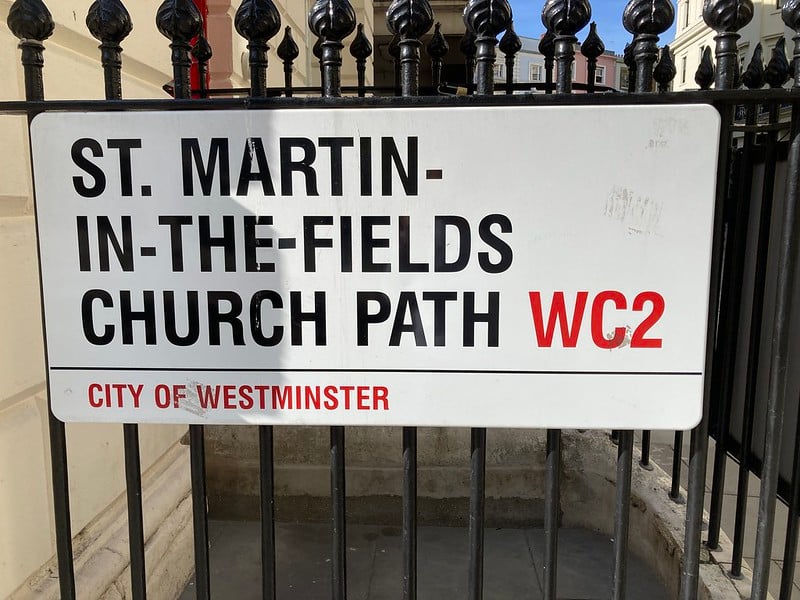
Should this count? Though it is, being right next to Trafalgar Square, quite grand for a path running next to a church, it is, ultimately, a path running next to a church, albeit with some paving and a road sign, so is this a ‘road name’, as such? Perhaps the sign is important here - but then what’s to stop Newham from putting up some signs for City Of London Cemetery Boundary Path (37 characters)2 or Hillingdon making a claim for Provident Industrial Estate Access Road (39 letters), both of which appear in the National Street Gazetteer, which St. Martin-in-the-Fields Church Path doesn’t.
One distinction we can make here is between a description of a road and the name of a road, which is complicated because lots of road names started as descriptions - e.g. the many, many London Roads that got the name because that was the road you took out of where you were to get to London.
And, consulting the National Street Gazetteer’s list, Redbridge’s “Footpath From The End Of Footpath No 45 Skirting The Golf Course To Its Junction With Footpath No 47” (100 characters) is not, realistically, a street name, even if it listed as such for certain official purposes.3
But perhaps St. Martin-In-The Fields Church Path is a description that has become a name. When exactly did this happen? The road signs aren’t visible in the earliest Google StreetView imagery, but when those photos were taken in 2008 the church was in the middle of a redevelopment scheme, so the path was blocked off by hoardings - the signs could be behind those, but I can’t find any obvious references to the ‘name’ before that.
If it is a named street, there are no addresses on it, according to Royal Mail’s online postcode finder. When I e-mailed the council they said they were ‘unable to track any records’. Very convenient.
Is it possible that Westminster council and St. Martin-In-The Fields have engaged in a deliberate and nefarious scheme to steal the glory of having the longest London road name from Stoke Newington and its Church? If you know anything about this evil plan and can help me compile evidence for my special dossier, please let me know. I will be writing to Keir Starmer about this. Something must be done.4
London’s longest Mews name, by the way, is a tie between Grosvenor Gardens Mews North and Grosvenor Gardens Mews South (28 letters), unless you count Access Road To The National Hospital Known As Grenville Mews (60 letters), which is obviously cheating unless Camden Council fancy putting up a really long road sign for some dubious publicity value.
THE MEWSES
#121 Powis Mews, Kensington and Chelsea, W11
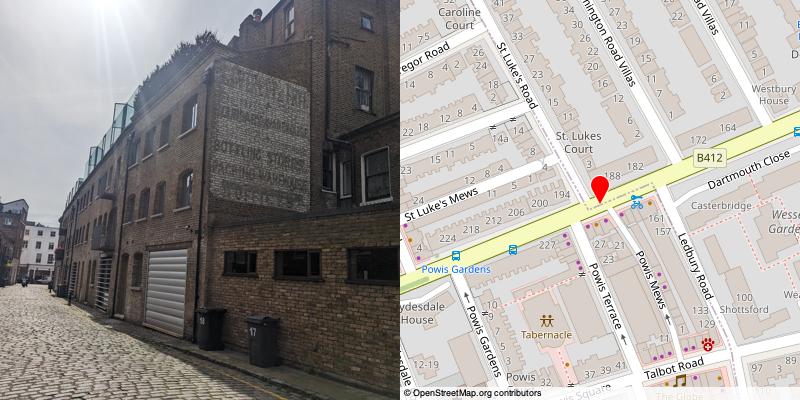
Home to, among other things, a Ghost Sign, i.e. a faded advertisement for Leverett & Frye’s Boundary Warehouse. Leverett & Frye was a fairly successful chain of high class grocers, until someone invented supermarkets and ruined things. In the company’s final days in the 1960s, it had a general manager named Michael Wogan, who had a quite famous son called Albert Ein… (checks notes) Terry Wogan (ask your dad). Wogan Senior, at one time in his Leverett & Frye career, managed a branch in Limerick that latterly became a shop specialising in Timberland boots, whose owners claim that Sir Terry used to occasionally pop in to point out where the carrots used to be and so on. It is good to have a hobby.
Meanwhile, back in Kensington, what’s a ‘Boundary Warehouse’ when it’s at home? Does it stock copies of books about boundaries?5 Actually, it just refers to where the warehouse was - on the boundary between Kensington and Paddington, and on a road called Boundary Mews. To avoid confusion with a (since demolished) road of the same name in Hampstead the London County Council renamed it to fit in with the nearby Powis Square, Gardens & Terrace, which I’m sure never causes any parcels to get delivered to the wrong place ever.
#122 Lonsdale Mews, Kensington and Chelsea, W11

A Russian doll of Mewses here, with Londsdale Mews running off Colville Mews. In 1899 these mewses were described as “dirty, wet and crowded” and things hadn’t got much better 50 years later when they were marked for slum clearance. Londsdale Mews is consequently now entirely comprised of lockups, mostly used by Portabello market traders.
Mid-20th century maps show a large building at the end of the Mews labelled “Sub-standard film development works” - was the film substandard, the film development substandard, or the film development works itself substandard? Further research reveals that this is what they used to call 16mm film (35mm being the ‘standard’ size), and at one time there was a Sub-standard Film magazine - an edition I found listed on eBay promises that BIG ONES are coming in 16mm. Nice!
#123 Colville Mews, Kensington and Chelsea, W11
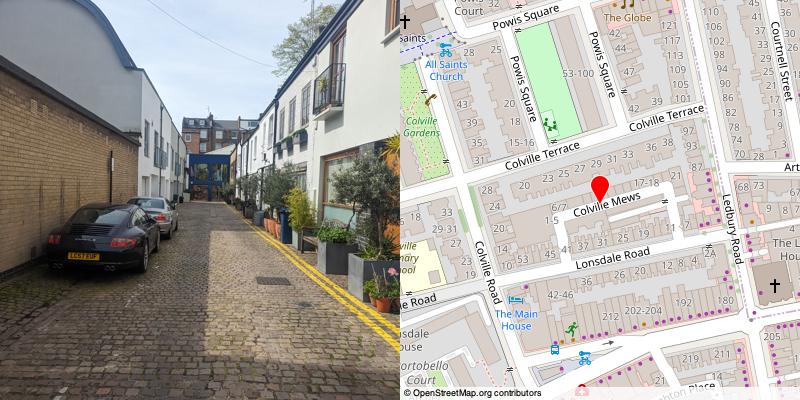
Once the home of museum of BRANDS but they must have got too many BRANDS because they had to move and now the Mews has a wellness spa instead.
#124 Rosehart Mews, Kensington and Chelsea, W11
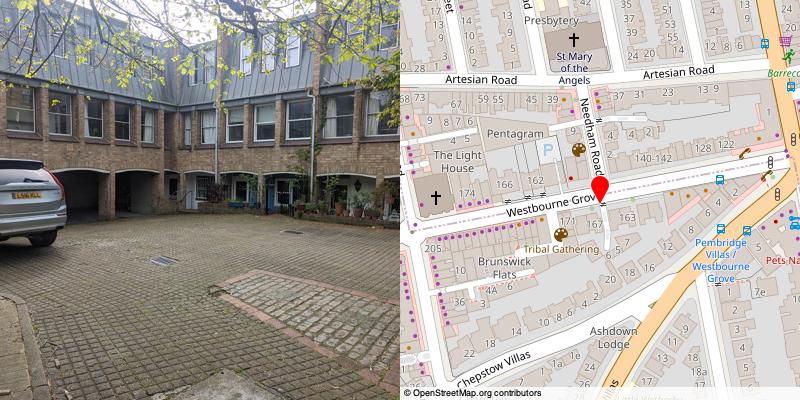
1970s redevelopment of an older mews into at least marginally interesting housing. As far as I can tell has made no significant impact on history other than appearing in a novel called The Book of Magic by Alice Hoffman, a sequel to the book Practical Magic, which got turned into the film Practical Magic' with Sandra Bullock and Nicole Kidman. So maybe if for some reason they decide to make a sequel to the critically panned box office bomb Practical Magic, Sandra Bullock and Nicole Kidman will have to come here to film the bit where they meet ‘Professor Ian Wright’ (???).
#125 Westbourne Grove Mews, Kensington and Chelsea, W11

A fair few original buildings survive here repurposed for upmarket homes and businesses - one that doesn’t but has been redeveloped ‘sympathetically’ features a two storey basement including an underground swimming pool. Probably buy that when I get really rich off looking up old mewses in newspaper archives.
The mews was, as of 1972, home to Jackie Hribal, that year’s “Miss Wavy Line”, anointed by judges including the former Lord Mayor of London and Peter Purves off of Blue Peter. After a few minutes of trying to decide whether or not the title “Miss Wavy Line” was in some way disturbing, I decided to look it up and the contest was sponsored by the Wavy Line organisation - a chain formed by small shopkeepers trying to survive in the face of competition from the supermarkets that doesn’t appears to have survived the 1980s
All I’m saying is they’re putting in one of those little Tescos down the end of our road and it will definitely be better than the shop that used to be where they tried to give you your change in sweets and pestered people waiting for the bus with ‘good deals’ on manky bananas.
#126 Ledbury Mews North, Kensington and Chelsea, W11

Albert Morris, of 3 Ledbury Mews North, had lung troubles entirely cured by ‘Dr Williams’ Pink Pills’, according to his testimonial in a 1906 newspaper advert. Dr. Williams' Pink Pills for Pale People originated in Canada, promised to solve more or less any health problem, and remarkably, they were available for sale in the UK until the 1970s. According to research published in the British Medical Journal in 1909 they did not contain arsenic, so there’s that at least.
#127 Ledbury Mews West, Kensington and Chelsea, W11
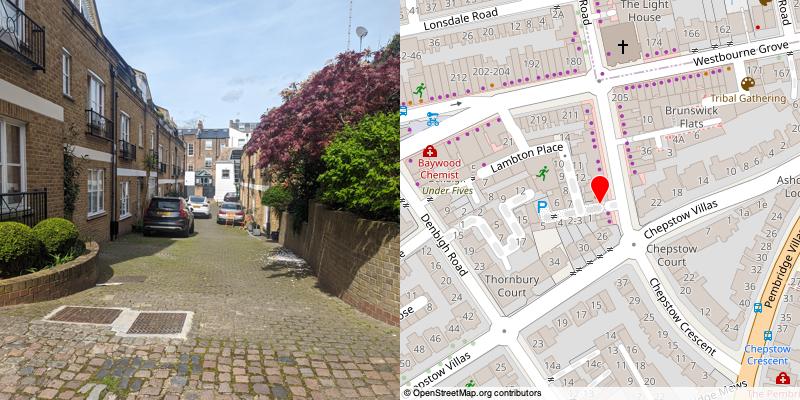
There’s some ambiguity about the original name here, with some early maps calling it Ledbury Mews South, which was at least a consistent naming scheme with it’s ‘brother Mews’ to the north, although given their relative positions with regards to Ledbury Road, East and West would be more logical.
To make matters more confusing, Ledbury Mews West now runs West and North, the garage shown on 1950s maps having been redeveloped at some point into a residential street. Worse still, Stanford's indexed atlas of the County of London, published 1911, includes a Ledbury Mews East. It is chaos out here on the Ledbury Mewses, I tell you.
#128 Pencombe Mews, Kensington and Chelsea, W11

The property page of the 1st June 1984 Illustrated London News informs us that it is ‘relatively easy to get a mortgage’ and suggests this, then brand new, development as an example of what to do with one, though is a bit sniffy about the lack of separate dining rooms. Oh thanks for letting us know, can’t be buying a house in Kensington without a separate dining room can I? Apparently they do all have bidets, so ideal for people with dirty bottoms.
#129 Pembridge Mews, Kensington and Chelsea, W11
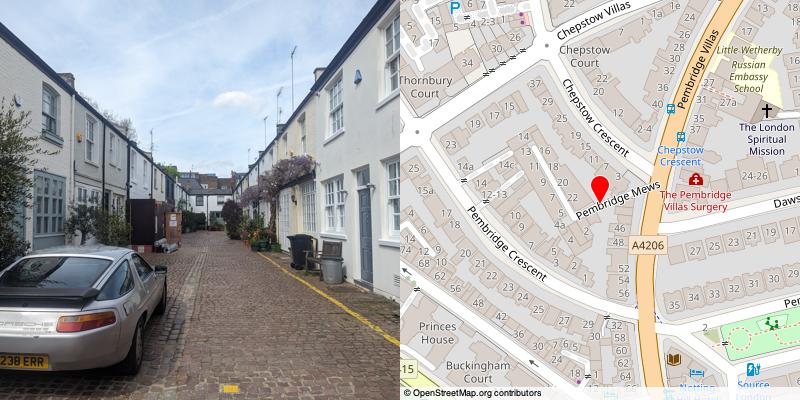
The guy who developed this area and thus got to name the streets was from Herefordshire, hence various places in that general vicinity are ‘celebrated’ here: Pembridge, Pencombe, Chepstow. It’s good that the naming methodology for so many streets was ‘What could some rich guy remember off the top of his head?’
In the 1980s a Dutch conman called Roland O’Garrow managed to persuade pop singer Michelle Gold to let him move into her Mews flat here (the local paper story where I learned about this says she was a ‘Top 40 pop singer’ but the Official Charts website has no record of her ‘hit’, Lost in Love - perhaps it was in a Top 40 rather than the Top 40), before rinsing her for thousands of pounds and getting her to commit fraud on his behalf.
The defence’s main argument for the conman’s innocence, was that he was “something of a Walter Mitty character”, which is weird because I saw that film and I don’t remember Ben Stiller getting wannabe pop stars to do traveller’s cheque related scams, but it was quite boring so maybe I fell asleep at some point.
Other former residents include fatwa-ed author Salman Rushdie, who at one point lived here in a flat rented from, all of people, Jason Donovan. (He later lived in Colville Mews, see above, making this Mews Letter the Salman Rushdie special. This information comes from a book he wrote himself, I promise I’m not trying to get him in any more bother.)
#130 Portobello Mews, Kensington and Chelsea, W11

I had to lurk for ages on the other side side of Portobello Road because a surly bloke was looming out of the Mews’ gate and I didn’t really fancy attempting to explain what I was doing, because it doesn’t make any sense.
Somewhere behind the gate there was once a pottery shed, belonging to the poet Ruth Pitter. Supposedly she let Eric Blair (i.e. George Orwell) use this to don his ‘down and out’ outfit before walking to the East End to research life as a vagrant. Blair/Orwell lived a few doors up from the Mews in a now appropriately blue-plaqued house - the use of the shed to switch into his ‘secret identity’ was perhaps necessary to avoid the consternation of his landlady, a snobbish former ladies maid.
Ruth Pitter once described Orwell’s early writing as being “like a cow with a musket”. Owned.
Mewses Visited So Far: 130/2380

Assuming we aren’t counting e.g. ‘A1’ as a name. ↩
Well, apart from the fact that it’s always completely overgrown. ↩
Sadly in the data I have, 100 characters is the limit for the name field and several entries get cut off at the limit, so I can’t say for sure what is the most implausibly long ‘name’ of this kind. ↩
To be clear, this is a joke and St Martin-in-the-Fields does lots of brilliant things including running a charity for the homeless. ↩
e.g. friend of the Mews Letter Jonn Elledge’s A History of the World in 47 Borders, available from all good bookshops, etc, etc. ↩
-
Wavy Line survived until 2010 according to Companies House: I remember the logo well from my childhood in the home counties. It's a shame they don't make literal-sounding company names and logos like that any more in these days of SEO!
Add a comment: